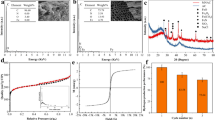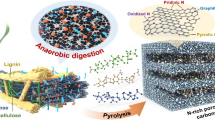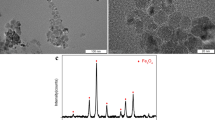Abstract
Magnetic activated carbon (MAC) was fabricated to improve biohydrogen (bio-H2) production. The MAC exhibited higher biocatalytic capability and better microbial immobilization than activated carbon (AC) during the bio-H2 process. Glucose supplemented with 200 mg/L MAC obtained the highest H2 yield of 214 mL/g glucose, much higher than that (130 mL/g glucose) of the control group without MAC. Suitable dosage such as 300 mg/L AC or 200 mg/L MAC promoted volatile fatty acid (VFA) formation and H2 generation. Besides, the metabolites showed that AC or MAC did not change the bio-H2 evolution pathway. Some possible biochemical mechanisms were as follows: MAC served as a microbial carrier to promote cell colonization and electron transfer rate, and it released Fe3+ to enhance glucose acidogenesis and Fe2+ to increase microbial concentration and activity in the bio-H2 evolution.

Magnetic activated carbon (MAC) was fabricated and subsequently used in bio-H2 process through glucose-fed anaerobic mixed bacteria at 37 °C. The MAC acted as a carrier of anaerobes to promote cell growth and electron transfer rate, and released Fe3+ to increase glucose acidogenesis and Fe2+ to improve microbial concentration and activity in the bio-H2 evolution process.








Similar content being viewed by others
References
Alatiqi, I. M., Hamoda, M. F., & Dadkhah, A. A. (1998). Kinetic analysis of thermophilic anaerobic digestion of wastewater sludge. Water Air & Soil Pollution, 107(1–4), 393–407.
Amin, M. M., Bina, B., Taheri, E., Zare, M. R., Ghasemian, M., Ginkel, S. W. V., & Fatehizadeh, A. (2017). Metabolism and kinetic study of bioH2 production by anaerobic sludge under different acid pretreatments. Process Biochemistry, 61, 24–29.
Azwar, M. Y., Hussain, M. A., & Abdul-Wahab, A. K. (2014). Development of biohydrogen production by photobiological, fermentation and electrochemical processes: A review. Renewable & Sustainable Energy Reviews, 31, 158–173.
Budiman, P. M., & Wu, T. Y. (2018). Role of chemicals addition in affecting biohydrogen production through photofermentation. Energy Conversion & Management, 165, 509–527.
Chen, J. L., Steele, T. W. J., & Stuckey, D. C. (2015). Modeling and application of a rapid fluorescence-based assay for biotoxicity in anaerobic digestion. Environmental Science Technology, 49, 1363–1371.
Dang, Y., Sun, D., Woodard, T. L., Wang, L. Y., Nevin, K. P., & Holmes, D. E. (2017). Stimulation of the anaerobic digestion of the dry organic fraction of municipal solid waste (OFMSW) with carbon-based conductive materials. Bioresource Technology, 238, 30–38.
Engliman, N. S., Abdul, P. M., Wu, S. Y., & Jahim, J. M. (2017). Influence of iron (II) oxide nanoparticle on biohydrogen production in thermophilic mixed fermentation. International Journal of Hydrogen Energy, 42(45), 27482–22793.
Fagbohungbe, M. O., Herbert, B. M. J., Hurst, L., Li, H., Usmani, S. Q., & Semple, K. T. (2016). Impact of biochar on the anaerobic digestion of citrus peel waste. Bioresource Technology, 216, 142–149.
Fagbohungbe, M. O., Herbert, B. M. J., Hurst, L., Ibeto, C. N., Li, H., Usmani, S. Q., & Semple, K. T. (2017). The challenges of anaerobic digestion and the role of biochar in optimizing anaerobic digestion. Waste Management, 61, 236–249.
Feng, Q., Song, Y.-C., Yoo, K., Kuppanan, N., Subudhi, S., & Lal, B. (2017). Influence of neutralization in acidic distillery wastewater on direct interspecies electron transfer for methane production in an upflow anaerobic bioelectrochemical reactor. International Journal of Hydrogen Energy, 42, 27774–27783.
Gadhe, A., Sonawane, S. S., & Varma, M. N. (2015). Influence of nickel and hematite nanoparticle powder on the production of biohydrogen from complex distillery wastewater in batch fermentation. International Journal of Hydrogen Energy, 40(34), 10734–10743.
Gong, W. J., Liang, H., & Li, W. Z. (2011). Selection and evaluation of biofilm carrier in anaerobic digestion treatment of cattle manure. Energies, 36, 3572–3578.
Gong, Y., Wang, L., Liu, J., Tang, J., & Zhao, D. (2016). Removal of aqueous perfluorooctanoic acid (PFOA) using starch-stabilized magnetite nanoparticles. Science of the Total Environment, 562, 191–200.
Han, S. K., Kim, S. H., & Shin, H. S. (2005). UASB treatment of wastewater with VFA and alcohol generated during hydrogen fermentation of food waste. Process Biochemistry, 40, 2897–2905.
Han, H., Cui, M., Wei, L., Yang, H., & Shen, J. (2011). Enhancement effect of hematite nanoparticles on fermentative hydrogen production. Bioresource Technology, 102, 7903–7909.
Han, W., Liu, D. N., Shi, Y. W., Tang, J. H., Li, Y. F., & Ren, N. Q. (2015). Biohydrogen production from food waste hydrolysate using continuous mixed immobilized sludge reactors. Bioresource Technology, 180, 54–58.
Han, W., Ye, M., Zhu, A. J., Huang, J. G., Zhao, H. T., & Li, Y. F. (2016). A combined bioprocess based on solid-state fermentation for dark fermentative hydrogen production from food waste. Journal of Cleaner Production, 112, 3744–3749.
Hwang, Y., Sivagurunathan, P., Lee, M. K., Yun, Y. M., Song, Y. C., & Kim, D. H. (2019). Enhanced hydrogen fermentation by zero valent iron addition. International Journal of Hydrogen Energy, 44(6), 3387–3394.
Jiang, X., Hu, J., Lieber, A. M., Jackan, C. S., Biffinger, J. C., Fitzgerald, L. A., Ringeisen, B. R., & Lieber, C. M. (2014). Nanoparticle facilitated extracellular electron transfer in microbial fuel cells. Nano Letters, 14, 6737–6742.
Jing, Y., Wan, J., Angelidaki, I., Zhang, S., & Luo, G. (2017). iTRAQ quantitative proteomic analysis reveals the pathways for methanation of propionate facilitated by magnetite. Water Research, 108, 212–221.
Karadag, D., & Puhakka, J. A. (2010). Enhancement of anaerobic hydrogen production by iron and nickel. International Journal of Hydrogen Energy, 35(16), 8554–8560.
Kim, S. H., Han, S. K., & Shin, H. S. (2006). Effect of substrate concentration on hydrogen production and 16S rDNA-based analysis of the microbial community in a continuous fermenter. Process Biochemistry, 41, 199–207.
Kothari, R., Singh, D. P., Tyagi, V. V., & Tyagi, S. K. (2012). Fermentative hydrogen production-An alternative clean energy source. Renewable & Sustainable Energy Reviews, 16, 2337–2346.
Lay, J. J., Lee, Y. J., & Noike, T. (1999). Feasibility of biological hydrogen production from organic fraction of municipal solid waste. Water Research, 33, 2579–2586.
Lin, R., Cheng, J., Ding, L., Song, W., Liu, M., Zhou, J., & Cen, K. (2016). Enhanced dark hydrogen fermentation by addition of ferric oxide nanoparticles using Enterobacter aerogenes. Bioresource Technology, 207, 213–219.
Liu, Z., Lv, F., Zheng, H., Zhang, C., Wei, F., & Xing, X. H. (2012a). Enhanced hydrogen production in a UASB reactor by retaining microbial consortium onto carbon nanotubes (CNTs). International Journal of Hydrogen Energy, 37, 10619–10626.
Liu, Y., Zhang, Y., Quan, X., Li, Y., Zhao, Z., Meng, X., & Chen, S. (2012b). Optimization of anaerobic acidogenesis by adding Fe0 powder to enhance wastewater treatment. Chemical Engineering Journal, 192, 179–185.
Mishra, P., Singh, L., Wahid, Z. A., Krishnan, S., Rana, S., Islam, M. A., Sakinah, M., Ameen, F., & Syed, A. (2018). Photohydrogen production from dark-fermented palm oil mill effluent (DPOME) and statistical optimization: Renewable substrate for hydrogen. Journal of Cleaner Production, 199, 11–17.
Mohanraj, S., Kodhaiyolii, S., Rengasamy, M., & Pugalenthi, V. (2014). Phytosynthesized iron oxide nanoparticles and ferrous iron on fermentative hydrogen production using Enterobacter cloacae: Evaluation and comparison of the effects. International Journal of Hydrogen Energy, 39, 11920–11929.
Mostafa, A., El-Dissouky, A., Fawzy, A., Peu, P., Roux, S. L., & Tawfik, A. (2016). Magnetite/grapheme oxide nano-composite for enhancement of hydrogen production from gelatinaceous wastewater. Bioresource Technology, 216, 520–528.
Mu, Y., Wang, G., & Yu, H. Q. (2006). Kinetic modeling of batch hydrogen production process by mixed anaerobic cultures. Bio/Technology, 97(11), 1302–1307.
Mumme, J., Srocke, F., Heeg, K., & Werner, M. (2014). Use of biochars in anaerobic digestion. Bioresource Technology, 164, 189–197.
Nasr, M., Tawfik, A., Ookawara, S., Suzuki, M., Kumari, S., & Bux, F. (2015). Continuous biohydrogen production from starch wastewater via sequential dark-photo fermentation with emphasize on maghemite nanoparticles. Journal of Industrial & Engineering Chemistry, 21, 500–506.
Park, J. H., Yoon, J. J., Park, H. D., Kim, Y. J., Lim, D. J., & Kim, S. H. (2006). Feasibility of biohydrogen production from Gelidium amansii. International Journal of Hydrogen Energy, 36, 13997–14003.
Qin, Y., Wang, H., Li, X., Cheng, J. J., & Wu, W. (2017). Improving methane yield from organic fraction of municipal solid waste (OFMSW) with magnetic rice-straw biochar. Bioresource Technology, 245, 1058–1066.
Rattanachueskul, N., Saning, A., Kaowphong, S., Chumha, N., & Chuenchom, L. (2017). Magnetic carbon composites with a hierarchical structure for adsorption of tetracycline, prepared from sugarcane bagasse via hydrothermal carbonization coupled with simple heat treatment process. Bioresource Technology, 266, 164–172.
Saraphirom, P., & Reungsang, A. (2011). Biological hydrogen production from sweet sorghum syrup by mixed cultures using an anaerobic sequencing batch reactor (ASBR). International Journal of Hydrogen Energy, 36(14), 8765–7873.
Sunyoto, N. M. S., Zhu, M., Zhang, Z., & Zhang, D. (2016). Effect of biochar addition on hydrogen and methane production in two-phase anaerobic digestion of aqueous carbohydrates food waste. Bioresource Technology, 219, 29–36.
Taherdanak, M., Zilouei, H., & Karimi, K. (2016). The effects of Fe0 and Ni0 nanoparticles versus Fe2+ and Ni2+ ions on dark hydrogen fermentation. International Journal of Hydrogen Energy, 41, 167–173.
Van Ginkel, S. W., & Logan, B. (2005). Increased biological hydrogen production with reduced organic loading. Water Research, 39(16), 3819–3826.
Wang, J., & Wan, W. (2008). Effect of Fe2+ concentration on fermentative hydrogen production by mixed cultures. International Journal of Hydrogen Energy, 33(4), 215–220.
Yang, Y., Dong, H., Wang, Y., He, C., Wang, Y., & Zhang, X. (2018). Synthesis of octahedral like Cu-BTC derivatives derived from MOF calcined under different atmosphere for application in CO oxidation. Journal of Solid State Chemistry, 258, 582–587.
Zaidi, A. A., RuiZhe, F., Shi, Y., Khan, S. Z., & Mushtaq, K. (2018). Nanoparticles augmentation on biogas yield from microalgal biomass anaerobic digestion. International Journal of Hydrogen Energy, 43(31), 14202–14213.
Zhang, Z. P., Show, K. Y., Taya, J. H., Liang, D. T., & Lee, D. J. (2008). Biohydrogen production with anaerobic fluidized bed reactors-a comparison of biofilm-based and granule-based systems. International Journal of Hydrogen Energy, 33, 1559–1564.
Zhang, C., Lv, F. X., & Xing, X. H. (2011). Bioengineering of the Enterobacter aerogenes strain for biohydrogen production. Bioresource Technology, 102, 8344–8349.
Zhang, J., Wang, Q., & Jiang, J. (2013). Lime mud from paper-making process addition to food waste synergistically enhances hydrogen fermentation performance. International Journal of Hydrogen Energy, 38(6), 2738–2745.
Zhang, L., Zhang, L., & Li, D. (2015a). Enhanced dark fermentative hydrogen production by zero-valent iron activated carbon microelectrolysis. International Journal of Hydrogen Energy, 40, 12201–12208.
Zhang, J., Zhang, J., & Zang, L. (2015b). Thermophilic bio-hydrogen production from corn-bran residue pretreated by calcined-lime mud from paper-making process. Bioresource Technology, 198, 564–570.
Zhang, J., Fan, C., & Zang, L. (2017). Improvement of hydrogen production from glucose by ferrous iron and biocar. Bioresource Technology, 245, 98–105.
Zhang, J., Fan, C., Zhang, H., Wang, Z., Zhang, J., & Song, M. (2018a). Ferric oxide/ carbon nanoparticles enhanced bio-hydrogen production from glucose. International Journal of Hydrogen Energy, 43, 8729–8738.
Zhang, J., Zhao, W., Zhang, H., Wang, Z., Fan, C., & Zang, L. (2018b). Recent achievements in enhancing anaerobic digestion with carbon-based functional materials. Bioresource Technology, 266, 555–567.
Zhang, J., Yao, C., & Fan, C. (2018c). Enhancement of solubility and biohydrogen production from sewage sludge with lime mud filtrate. Water Air & Soil Pollution, 229, 129–136.
Zheng, J., Liu, Z. Q., Zhao, X. S., Liu, M., Liu, x., & Chu, W. (2012). One-step solvothermal synthesis of Fe3O4@C core-shell nanoparticles with tunable sizes. Nanotechnology, 23, 165601–165609.
Funding
This study was funded by the Shandong Province Natural Science Foundation-China (ZR2016EEM33).
Author information
Authors and Affiliations
Corresponding author
Additional information
Publisher’s Note
Springer Nature remains neutral with regard to jurisdictional claims in published maps and institutional affiliations.
Highlights
• Magnetic activated carbon (MAC) has higher biocatalytic capacity than AC.
• Suitable dosage of MAC promoted microbial activity and electron transfer.
• MAC could facilitate hydrogen-producing bacteria richness and growth.
• The highest H2 yield of 214 mL/g glucose was obtained at 200 mg/L MAC.
• The modified Gompertz model fitted well the bio-H2 evolution process.
Rights and permissions
About this article
Cite this article
Fan, C., Zhang, J. & Zang, L. Improving Biohydrogen Evolution from Glucose with Magnetic Activated Carbon. Water Air Soil Pollut 230, 100 (2019). https://doi.org/10.1007/s11270-019-4155-4
Received:
Accepted:
Published:
DOI: https://doi.org/10.1007/s11270-019-4155-4




